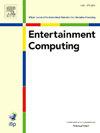数据新闻可以被嗤之以鼻吗?探索嗅觉接口用于数据新闻信息表示的可能性
IF 2.4
3区 计算机科学
Q2 COMPUTER SCIENCE, CYBERNETICS
引用次数: 0
摘要
近年来,数据新闻在全球范围内取得了显著增长,但其呈现方式仍然是视觉化的。随着感官新闻和沉浸式技术的进步,嗅觉作为数据新闻的界面,有可能为用户带来独特的体验和价值。在这项研究中,我们创新地使用嗅觉交互技术,开发了一个用于数据新闻的原型嗅觉设备。然后,进行了一项试点研究(N = 36),以评估嗅觉界面对用户感知、体验和记忆的影响。初步结果表明,嗅觉界面在几个方面都是有效的,包括帮助讲故事,增强用户对新闻内容(尤其是定性数据)的长期记忆,以及增加用户的参与度和沉浸感。我们进一步分享了我们在嗅觉映射方法、嗅觉接口在数据新闻中的价值、面临的挑战以及未来应用范围方面的经验、设计见解和经验教训。虽然嗅觉界面还处于初级阶段,但它在丰富数据新闻体验方面显示出了相当大的前景。本文章由计算机程序翻译,如有差异,请以英文原文为准。
Can data journalism be sniffed? Exploring the possibilities of olfactory interfaces for the presentation of data journalism information
In recent years, data journalism has seen significant global growth, yet its presentation remains visual. With the advancement of sensory journalism and immersive technologies, olfaction has the potential to bring a unique experience and value to users as an interface for data journalism. In this study, we innovatively used olfactory interaction technology and developed a prototype olfactory device for data journalism. Then, a pilot study (N = 36) was conducted to evaluate the impact of the olfaction interface on users’ perception, experience, and memory. Preliminary results suggest that the olfactory interface is effective in several ways, including aiding storytelling, enhancing users’ long-term memory of news content (especially qualitative data), and increasing user engagement and immersion. We further shared our experiences, design insights, and lessons learned regarding the olfactory mapping method, the olfactory interface’s value in data journalism, the challenges faced, and the scope for future applications. While still in its nascent stages, olfactory interfaces show considerable promise for enriching the data journalism experience.
求助全文
通过发布文献求助,成功后即可免费获取论文全文。
去求助
来源期刊

Entertainment Computing
Computer Science-Human-Computer Interaction
CiteScore
5.90
自引率
7.10%
发文量
66
期刊介绍:
Entertainment Computing publishes original, peer-reviewed research articles and serves as a forum for stimulating and disseminating innovative research ideas, emerging technologies, empirical investigations, state-of-the-art methods and tools in all aspects of digital entertainment, new media, entertainment computing, gaming, robotics, toys and applications among researchers, engineers, social scientists, artists and practitioners. Theoretical, technical, empirical, survey articles and case studies are all appropriate to the journal.
 求助内容:
求助内容: 应助结果提醒方式:
应助结果提醒方式:


